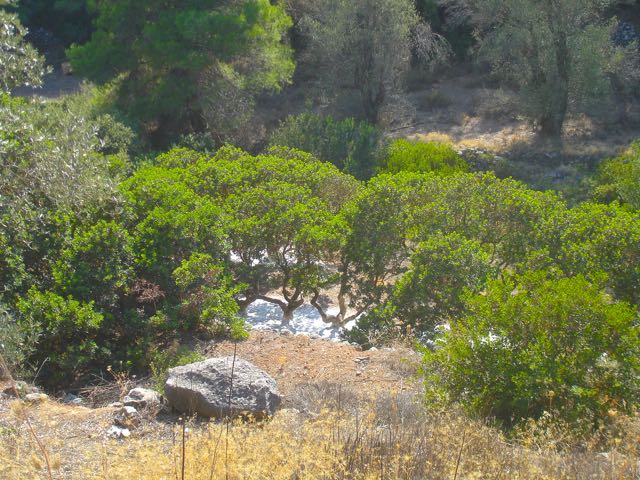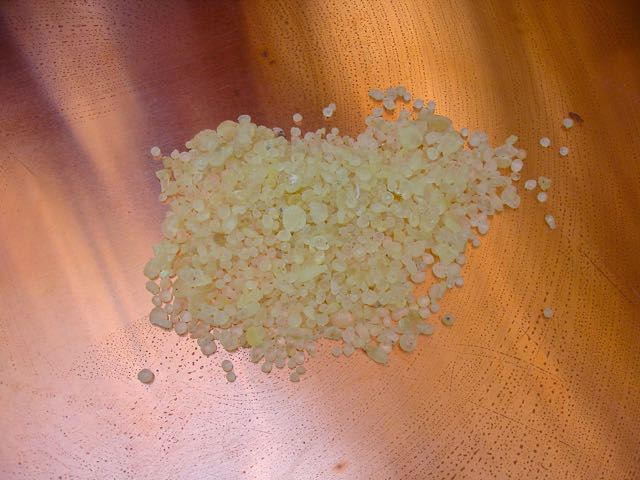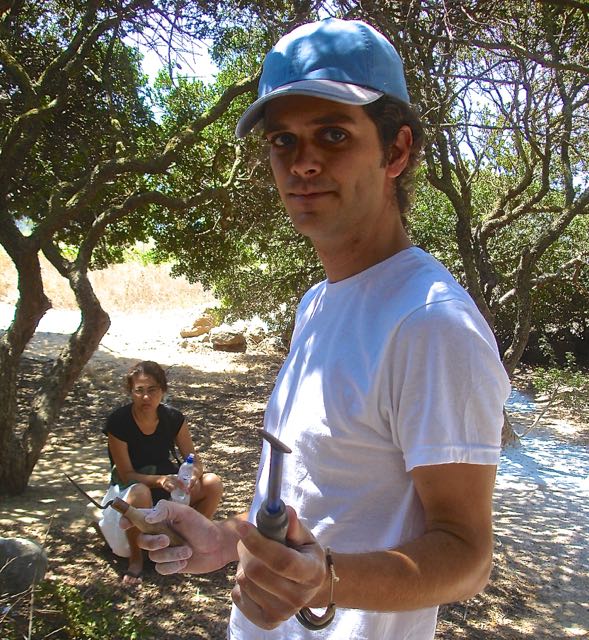|
 Mastica is made from the sap of the tree Pistachia Lentiscus var. chia, which is grown only on the southern coast of Chios. Mastica has been cultivated since ancient times due to its healing properties, unique taste and the large number of uses the product
has. Mastic has been mentioned in the writings of Plinius, Theophrastus, Hippocrates, Apollodorus
and even Christopher Columbus who announced both the discovery of the New World and mastic in the same sentence in a letter to Luis De Saint Angel, the treasurer of Aragon. It was of such importance that the villages of Chios that produced were usually spared by conquerors and given special privileges so they could continue to produce it even while the inhabitants of other towns were massacred and sold into slavery. During the Byzantine Empire mastica was a monopoly of the Emperor, sold all over Europe and
was said to be as valuable as gold. The villages that grew mastica were transformed into fortresses to protect the product from the invasion of pirates and other lowlifes. Mastica is made from the sap of the tree Pistachia Lentiscus var. chia, which is grown only on the southern coast of Chios. Mastica has been cultivated since ancient times due to its healing properties, unique taste and the large number of uses the product
has. Mastic has been mentioned in the writings of Plinius, Theophrastus, Hippocrates, Apollodorus
and even Christopher Columbus who announced both the discovery of the New World and mastic in the same sentence in a letter to Luis De Saint Angel, the treasurer of Aragon. It was of such importance that the villages of Chios that produced were usually spared by conquerors and given special privileges so they could continue to produce it even while the inhabitants of other towns were massacred and sold into slavery. During the Byzantine Empire mastica was a monopoly of the Emperor, sold all over Europe and
was said to be as valuable as gold. The villages that grew mastica were transformed into fortresses to protect the product from the invasion of pirates and other lowlifes.
|
|
 There are more than 60 uses of gum mastic in foods, paints, varnishes, drinks, toothpaste, shampoo and soaps and in medicine where it is said to heal ulcers, reduce blood pressure, cholesterol and diabetes and strengthen the immune system. The ancient Greeks used it to fight inflammation, coughs and bladder infections.
It is also the main
ingredient in a number of beauty products like cleansing lotions, skin creams for revitalization, moisturizers, anti-fungals, and soaps. The Koran advises the Muslims to use mastica and put it in their bread while the Egyptians used it to make bad-tasting water more palatable. Its antibacterial properties made it an effective weapon against cholera. Chewing mastica reduces bacterial plaque by 41.5% according to studies by the University of Thessaloniki. Nottingham University Clinic claims that one gram of mastic
every day for two weeks can cure peptic ulcers. There are more than 60 uses of gum mastic in foods, paints, varnishes, drinks, toothpaste, shampoo and soaps and in medicine where it is said to heal ulcers, reduce blood pressure, cholesterol and diabetes and strengthen the immune system. The ancient Greeks used it to fight inflammation, coughs and bladder infections.
It is also the main
ingredient in a number of beauty products like cleansing lotions, skin creams for revitalization, moisturizers, anti-fungals, and soaps. The Koran advises the Muslims to use mastica and put it in their bread while the Egyptians used it to make bad-tasting water more palatable. Its antibacterial properties made it an effective weapon against cholera. Chewing mastica reduces bacterial plaque by 41.5% according to studies by the University of Thessaloniki. Nottingham University Clinic claims that one gram of mastic
every day for two weeks can cure peptic ulcers.
|
|
 The process of extracting mastica from the trees is a tedious one and takes place from June through September. First the area beneath the tree is swept clean of leaves, dirt, sticks and incects. The ground is covered with a pure white soil. The park is cut in a series of lines and the pearly white gum
slowly drips
out and is collected from the tree and from the white soil beneath it. According to local legends the mastic are tears cried for the saint Isidoros who was tortured beneath a mastic tree in 253 AD. After the gum is collected it is cleaned bit by bit in the villages where it is somewhat of a social event. It is then sold to the cooperative of Mastic Producers of Chios who have had a monopoly on the product for the last seventy years. One fully grown mastica tree will produce between 200 and 400 grams of
mastica annually. There is even a mastica soda sold on Chios. Is it good? Well not at first. It tastes kind of stale or moldy despite being sweet and carbonated. I had trouble finishing it. But then I began craving the taste like my body wanted it or something. So if you listen to your body it is either very good for you like when you crave greens or fruit, or very bad for you like when you crave nachos or a hotdog. But it is worth trying. The process of extracting mastica from the trees is a tedious one and takes place from June through September. First the area beneath the tree is swept clean of leaves, dirt, sticks and incects. The ground is covered with a pure white soil. The park is cut in a series of lines and the pearly white gum
slowly drips
out and is collected from the tree and from the white soil beneath it. According to local legends the mastic are tears cried for the saint Isidoros who was tortured beneath a mastic tree in 253 AD. After the gum is collected it is cleaned bit by bit in the villages where it is somewhat of a social event. It is then sold to the cooperative of Mastic Producers of Chios who have had a monopoly on the product for the last seventy years. One fully grown mastica tree will produce between 200 and 400 grams of
mastica annually. There is even a mastica soda sold on Chios. Is it good? Well not at first. It tastes kind of stale or moldy despite being sweet and carbonated. I had trouble finishing it. But then I began craving the taste like my body wanted it or something. So if you listen to your body it is either very good for you like when you crave greens or fruit, or very bad for you like when you crave nachos or a hotdog. But it is worth trying.
|
|
Learn all about he cultivation and production of Mastica as well as other traditional classes and eco-tourism programs by visiting Masticulture Ecotourism Activities
|
|

 Mastica is made from the sap of the tree Pistachia Lentiscus var. chia, which is grown only on the southern coast of Chios. Mastica has been cultivated since ancient times due to its healing properties, unique taste and the large number of uses the product
has. Mastic has been mentioned in the writings of Plinius, Theophrastus, Hippocrates, Apollodorus
and even Christopher Columbus who announced both the discovery of the New World and mastic in the same sentence in a letter to Luis De Saint Angel, the treasurer of Aragon. It was of such importance that the villages of Chios that produced were usually spared by conquerors and given special privileges so they could continue to produce it even while the inhabitants of other towns were massacred and sold into slavery. During the Byzantine Empire mastica was a monopoly of the Emperor, sold all over Europe and
was said to be as valuable as gold. The villages that grew mastica were transformed into fortresses to protect the product from the invasion of pirates and other lowlifes.
Mastica is made from the sap of the tree Pistachia Lentiscus var. chia, which is grown only on the southern coast of Chios. Mastica has been cultivated since ancient times due to its healing properties, unique taste and the large number of uses the product
has. Mastic has been mentioned in the writings of Plinius, Theophrastus, Hippocrates, Apollodorus
and even Christopher Columbus who announced both the discovery of the New World and mastic in the same sentence in a letter to Luis De Saint Angel, the treasurer of Aragon. It was of such importance that the villages of Chios that produced were usually spared by conquerors and given special privileges so they could continue to produce it even while the inhabitants of other towns were massacred and sold into slavery. During the Byzantine Empire mastica was a monopoly of the Emperor, sold all over Europe and
was said to be as valuable as gold. The villages that grew mastica were transformed into fortresses to protect the product from the invasion of pirates and other lowlifes.  There are more than 60 uses of gum mastic in foods, paints, varnishes, drinks, toothpaste, shampoo and soaps and in medicine where it is said to heal ulcers, reduce blood pressure, cholesterol and diabetes and strengthen the immune system. The ancient Greeks used it to fight inflammation, coughs and bladder infections.
It is also the main
ingredient in a number of beauty products like cleansing lotions, skin creams for revitalization, moisturizers, anti-fungals, and soaps. The Koran advises the Muslims to use mastica and put it in their bread while the Egyptians used it to make bad-tasting water more palatable. Its antibacterial properties made it an effective weapon against cholera. Chewing mastica reduces bacterial plaque by 41.5% according to studies by the University of Thessaloniki. Nottingham University Clinic claims that one gram of mastic
every day for two weeks can cure peptic ulcers.
There are more than 60 uses of gum mastic in foods, paints, varnishes, drinks, toothpaste, shampoo and soaps and in medicine where it is said to heal ulcers, reduce blood pressure, cholesterol and diabetes and strengthen the immune system. The ancient Greeks used it to fight inflammation, coughs and bladder infections.
It is also the main
ingredient in a number of beauty products like cleansing lotions, skin creams for revitalization, moisturizers, anti-fungals, and soaps. The Koran advises the Muslims to use mastica and put it in their bread while the Egyptians used it to make bad-tasting water more palatable. Its antibacterial properties made it an effective weapon against cholera. Chewing mastica reduces bacterial plaque by 41.5% according to studies by the University of Thessaloniki. Nottingham University Clinic claims that one gram of mastic
every day for two weeks can cure peptic ulcers. The process of extracting mastica from the trees is a tedious one and takes place from June through September. First the area beneath the tree is swept clean of leaves, dirt, sticks and incects. The ground is covered with a pure white soil. The park is cut in a series of lines and the pearly white gum
slowly drips
out and is collected from the tree and from the white soil beneath it. According to local legends the mastic are tears cried for the saint Isidoros who was tortured beneath a mastic tree in 253 AD. After the gum is collected it is cleaned bit by bit in the villages where it is somewhat of a social event. It is then sold to the cooperative of Mastic Producers of Chios who have had a monopoly on the product for the last seventy years. One fully grown mastica tree will produce between 200 and 400 grams of
mastica annually. There is even a mastica soda sold on Chios. Is it good? Well not at first. It tastes kind of stale or moldy despite being sweet and carbonated. I had trouble finishing it. But then I began craving the taste like my body wanted it or something. So if you listen to your body it is either very good for you like when you crave greens or fruit, or very bad for you like when you crave nachos or a hotdog. But it is worth trying.
The process of extracting mastica from the trees is a tedious one and takes place from June through September. First the area beneath the tree is swept clean of leaves, dirt, sticks and incects. The ground is covered with a pure white soil. The park is cut in a series of lines and the pearly white gum
slowly drips
out and is collected from the tree and from the white soil beneath it. According to local legends the mastic are tears cried for the saint Isidoros who was tortured beneath a mastic tree in 253 AD. After the gum is collected it is cleaned bit by bit in the villages where it is somewhat of a social event. It is then sold to the cooperative of Mastic Producers of Chios who have had a monopoly on the product for the last seventy years. One fully grown mastica tree will produce between 200 and 400 grams of
mastica annually. There is even a mastica soda sold on Chios. Is it good? Well not at first. It tastes kind of stale or moldy despite being sweet and carbonated. I had trouble finishing it. But then I began craving the taste like my body wanted it or something. So if you listen to your body it is either very good for you like when you crave greens or fruit, or very bad for you like when you crave nachos or a hotdog. But it is worth trying.

